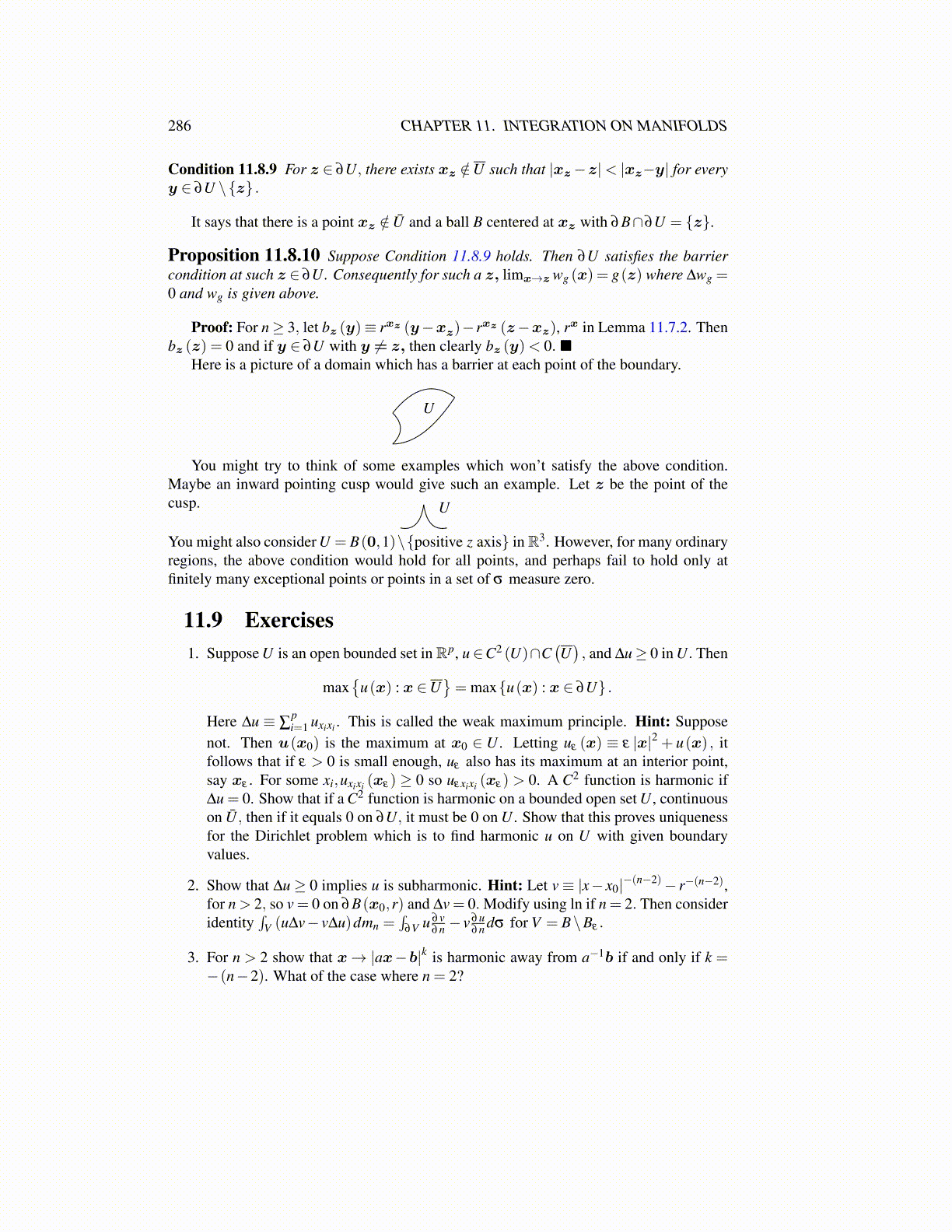
286 CHAPTER 11. INTEGRATION ON MANIFOLDS
Condition 11.8.9 For z ∈ ∂U, there exists xz /∈U such that |xz−z|< |xz−y| for everyy ∈ ∂U \{z} .
It says that there is a point xz /∈ Ū and a ball B centered at xz with ∂B∩∂U = {z}.
Proposition 11.8.10 Suppose Condition 11.8.9 holds. Then ∂U satisfies the barriercondition at such z ∈ ∂U. Consequently for such a z, limx→z wg (x) = g(z) where ∆wg =0 and wg is given above.
Proof: For n≥ 3, let bz (y)≡ rxz (y−xz)−rxz (z−xz), rx in Lemma 11.7.2. Thenbz (z) = 0 and if y ∈ ∂U with y ̸= z, then clearly bz (y)< 0. ■
Here is a picture of a domain which has a barrier at each point of the boundary.
U
You might try to think of some examples which won’t satisfy the above condition.Maybe an inward pointing cusp would give such an example. Let z be the point of thecusp. U
You might also consider U = B(0,1)\{positive z axis} inR3. However, for many ordinaryregions, the above condition would hold for all points, and perhaps fail to hold only atfinitely many exceptional points or points in a set of σ measure zero.
11.9 Exercises1. Suppose U is an open bounded set in Rp, u∈C2 (U)∩C
(U), and ∆u≥ 0 in U. Then
max{
u(x) : x ∈U}= max{u(x) : x ∈ ∂U} .
Here ∆u ≡ ∑pi=1 uxixi . This is called the weak maximum principle. Hint: Suppose
not. Then u(x0) is the maximum at x0 ∈ U . Letting uε (x) ≡ ε |x|2 + u(x) , itfollows that if ε > 0 is small enough, uε also has its maximum at an interior point,say xε . For some xi,uxixi (xε) ≥ 0 so uεxixi (xε) > 0. A C2 function is harmonic if∆u = 0. Show that if a C2 function is harmonic on a bounded open set U , continuouson Ū , then if it equals 0 on ∂U, it must be 0 on U . Show that this proves uniquenessfor the Dirichlet problem which is to find harmonic u on U with given boundaryvalues.
2. Show that ∆u≥ 0 implies u is subharmonic. Hint: Let v≡ |x− x0|−(n−2)− r−(n−2),for n > 2, so v = 0 on ∂B(x0,r) and ∆v = 0. Modify using ln if n = 2. Then consideridentity
∫V (u∆v− v∆u)dmn =
∫∂V u ∂v
∂n − v ∂u∂n dσ for V = B\Bε .
3. For n > 2 show that x→ |ax−b|k is harmonic away from a−1b if and only if k =−(n−2). What of the case where n = 2?